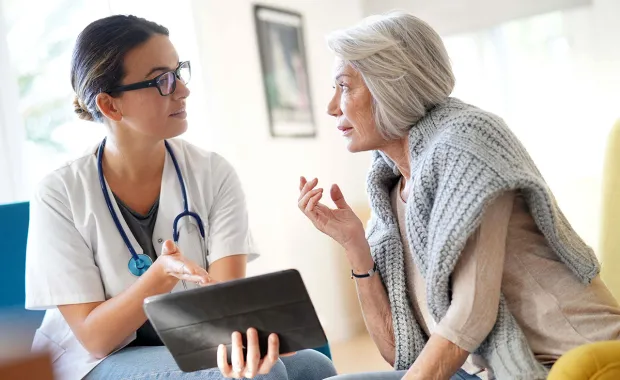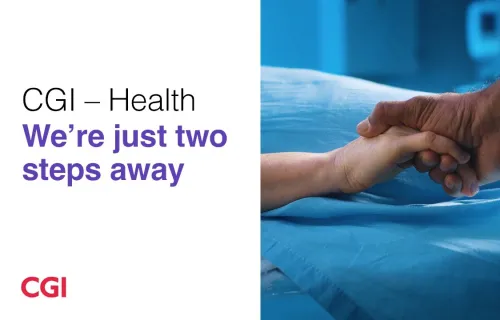There’s no place like home
Home truly is where the heart is. It’s a place of familiarity with the people and things around us and, for many of us, it’s the place where we feel most relaxed and happy. The sense of security often means that, when we need support with our health, home can offer one of the most comfortable paths to recovery.
The role our homes play in recovery is increasingly coming to the fore; particularly as health and care services face the converging challenge of aging citizenship, growing digital expectations and workforce fatigue. Magnified by Covid-19, this developing challenge has spurned a clear direction of travel toward person-centered health and care services. In practice, that means putting people at the center of their own healthcare and supporting them to be in their home environment as much as possible. In fact, in the CGI Voice of Our Clients conversations with health executives this year, improving the customer experience through compliance to treatment guidance and supporting the patient at home is the top business priority.
Digital technology is the key to unlocking community care
By helping people with less complex needs to recover at home, resources at hospitals and specialist providers are freed-up, allowing access to complicated treatments to become quicker and, as a result, often more effective. Achieving this in a safe and sustainable way means creating an ecosystem of healthcare partners that work together to provide people with the right care at the right time. The best way to build this is using digital technology to facilitate community-based services and remote monitoring.
Smarter home technology is just one piece of the puzzle. It can empower people to manage their own health while continuing to be active in their own community. As such, it shifts the focus from managing illness, to managing wellness—a far more holistic approach to health and care delivery. But transforming overarching healthcare service models to focus on community care and wellness management requires key digital capabilities, built on a robust digital architecture.
Integrated health and care data
The first thing to consider is data. Providing digitally-enabled healthcare services needs a foundation of seamless data access, sharing and digital consent management. It’s not just current data that’s important. It’s also vital to recognize the volume of data that new digital services will generate and to be strategic about how this feeds back into existing systems and services. Interoperable, bi-directional data is the heart of digital healthcare and ensures that the right information lands in the right hands in a timely way so it can be acted upon quickly and patient outcomes can be improved.
Citizen experience and engagement
Another cornerstone of this bold new model is active citizen participation in healthcare management. Extending health and care services, at scale, into homes and communities means people need to be able to interact with these services in a seamless way. People need access to an easy-to-use, omnichannel experience that guides them to the right channel for their immediate need and consolidates all previous interactions so they receive the most considered and effective response.
As personal devices like health wearables become more widely used, the scope of this engagement widens. Alongside control of healthcare data and access to multiple channels of communication, people can actively contribute to their care management by sharing personally generated health and fitness data. This level of interoperability and integration gives people control over their health journey and it’s critical to scalability and longevity. It’s also something we’re already familiar with thanks to the acceleration of various digital services across other sectors during the pandemic.
Colleague experience and collaboration
Patient care is just part of the picture. Helping health and care workers to effectively engage with patients and all other members of their care team is also vital. That means creating seamless channels of multi-disciplinary communication, so care providers, whether remote, hybrid or face-to-face, can give the most informed care, anywhere, anytime.
When workers have access to effective digital capabilities, devices and solutions, they’re able to view, action, refer and request information immediately. These digital solutions mean that people, the most highly skilled, highly valuable resources the health system holds, have access to the information and channels they need to deliver better care. For patients and caregivers alike, multi-channel interaction with an up-to-date care ecosystem is vital—and digital tools are the best way to achieve this.
Remote health and care monitoring
Helping people get home from the hospital sooner needs both at-home health monitoring and assisted living. Many people move across these services numerous times over the course of their lives, so it’s important to reimagine these as holistic, interoperable services. The best patient experience and outcome is delivered when monitoring and assisted living work together as a connected whole—and that requires kit, connectivity and secure data transfer to operate at scale. It also needs a significant service redesign and updated logistics management to underpin all aspects of care. It seems an enormous task, but learnings gained through healthcare’s rapid response to Covid-19 can help. Replicating pandemic-levels of agility at scale will bring with it a new set of digital challenges, but with collective will and access to the right tools, it is achievable.
Situational awareness—alert, alarms and actionable items
The final step in creating a care system that prioritizes at-home care is triangulating patients, healthcare workers and physical assets. Once healthcare equipment is mobilized and taken out of traditional physical buildings into the community, it’s important to create a higher level of situational awareness, so that care providers can get access to the tools they need to provide each patient with the best care. Establishing digital operations and control centers is an effective way to triangulate all the moving parts in this new picture. These centers manage monitoring, alerting and direct action, and they will be essential to delivering a new model of care. These capabilities will use artificial intelligence and other technologies to process patient data—taken from wearable devices and healthcare systems—and identify:
- Which patients are most in need of support now
- Which patients are likely to be in need in the next defined period
- Healthcare workers with the correct skills, availability and locality to support and manage real-time patient need and patient need over the next defined period
- What physical assets are operating, whether they are in good working order, connected to the correct systems and sending expected data to information hubs
- Whether a physical asset is due for an inspection, fix or update and the logistics this will require
- How services could be even better delivered in the future
A healthier future
Realizing this vision for healthcare will be a significant task, but it’s set to revolutionize the care we receive. It will bring care into the homes and communities of those who need it, and free up hospitals and acute services for others. By helping people to engage with their own care, and giving communities the tools to act swiftly in response to patient need, we can all take control of our health and wellbeing in the place we know best – home.
Find out more about CGI in health and care.






